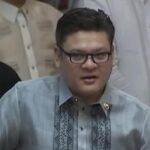President Ferdinand Marcos Jr. said the recently-completed renovation of the Philippine International Convention Center is a testament to what public infrastructure should be – modern, sturdy, and built to unite a nation and uphold its interests.
In his latest upload on his social media accounts, Marcos spoke fondly of the refurbished PICC ahead of the country’s hosting of the Association of Southeast Asian Nations next year.
He said the repairs are not just to physically restore the landmark – but are tangible efforts to promote Philippine history, culture, and Filipino excellence.
“That should be the quality of infrastructure that is sturdy and lasts for a long time, and constructed with the future in mind,” the President said.
“It has goals and aspirations that are not for one’s own interests, but for our nation. It unites people and is not a place of conflict,” he added.
Marcos said the renovated PICC, apart from being a venue for the ASEAN summits, reflects the Filipino culture in so many ways.
This is because the PICC is home to several beautiful art pieces, paintings, and sculptures of national significance.
“Our culture is our shared consciousness. It is what we share because we are Filipinos. The art form that we share, that is a Filipino art form. The way that we do our work, the way that we are with each other, that culture, that is our shared consciousness. So, it’s very, very important for us to know what is being Filipino, what a Filipino is,” he said.
He added that culture does not only define Filipinos as a people – it is also essential to nation-building.
“If we can define ourselves as one people, then we can also define the needs of that people and be willing to work together to bring us to the point where we have satisfied the needs of our people. That’s how important culture is,” the President said.
In late September, the Marcos family led the reopening of the PICC which was shut down for repairs ahead of its 50th anniversary and the 2026 ASEAN Summits.
“We will have many visitors and guests once more who are excited to see our country. We will make sure that we can be proud of the Philippines that they will see when they arrive,” the President said of the upcoming ASEAN Summits.
Marcos said he was pleased with the results of the major renovation, which was personally supervised by First Lady Liza Araneta-Marcos.
His mother, former First Lady Imelda Marcos, was also happy that the PICC is in pristine condition once more.
“She was happy and she was teasing us. She said, ‘Who built this?’ Of course we would say, ‘Mom, you did.’ She replied, ‘It’s beautiful, isn’t it?'” the President said.
Philippine International Convention Center
The Philippine International Convention Center (PICC) is a premier convention center in Manila, inaugurated in 1976 to host the International Monetary Fund (IMF) World Bank Annual Meetings. Designed by the renowned architect Leandro V. Locsin, it is a National Historical Landmark and a prime example of Philippine modernist architecture. It has since served as a major venue for numerous local and international conventions, exhibitions, and diplomatic events.
Association of Southeast Asian Nations
The Association of Southeast Asian Nations (ASEAN) is a regional intergovernmental organization established on August 8, 1967, by five founding members: Indonesia, Malaysia, the Philippines, Singapore, and Thailand. Its primary aim was to promote political and economic cooperation, along with regional stability, during the Cold War era. Today, it has grown to include ten member states and plays a central role in fostering economic integration, sociocultural progress, and diplomatic dialogue in Southeast Asia.
PICC
The Philippine International Convention Center (PICC) is a premier convention center in Manila, Philippines. It was inaugurated in 1976 to host the International Monetary Fund (IMF) World Bank Annual Meetings and was designed by the renowned Filipino architect Leandro V. Locsin. The PICC is considered a landmark of Philippine architecture and a major hub for international and local conventions, exhibitions, and cultural events.
ASEAN summits
ASEAN summits are the biannual meetings of leaders from the ten member states of the Association of Southeast Asian Nations, which was founded in 1967. These high-level forums serve as the primary platform for making key political and economic decisions, fostering regional cooperation, and addressing shared challenges. The summits have been instrumental in guiding the region’s integration, notably through initiatives like the ASEAN Community.
Filipino culture
Filipino culture is a vibrant fusion of indigenous, Spanish, American, and Asian influences, reflecting the Philippines’ complex history. This blend is evident in its major religion, Catholicism, its mix of local and Hispanic traditions like fiestas, and its arts, such as traditional folk dances and a globally recognized contemporary music scene. The culture is fundamentally characterized by strong family ties and community-oriented values like “utang na loob” (debt of gratitude) and “bayanihan” (communal unity).
Filipino art form
“Filipino art form” refers to a diverse range of creative expressions rooted in the Philippines’ complex history and cultural heritage. These forms, such as weaving, woodcarving, and dance, often reflect indigenous traditions as well as influences from Spanish, American, and Asian colonization. They serve as a vibrant testament to the Filipino people’s identity, resilience, and storytelling.
Filipino excellence
“Filipino excellence” is not a specific place but a cultural concept celebrating the remarkable achievements and global contributions of the Filipino people. It is rooted in a rich history of resilience and talent, demonstrated through world-class professionals in healthcare, arts, seafaring, and service industries. This spirit of excellence continues to be a defining national characteristic, earning international recognition and pride.
Philippine history
The Philippines has a rich and complex history shaped by centuries of colonization, beginning with Spanish rule in 1521 which introduced Christianity and a centralized government. This was followed by American administration after the 1898 Philippine Revolution, and a brief Japanese occupation during World War II, before the nation achieved full independence in 1946. This layered past has created a unique cultural identity that is a vibrant blend of indigenous, Asian, European, and American influences.






